In this article I have explained 10 simple automatic emergency light circuits using high bright LEDs. This circuit can be used during power failures and outdoors where any other source of power might be unavailable.
What's an Emergency Lamp
An emergency light is a circuit which automatically switches ON a battery operated lamp as soon as the mains AC input is unavailable or during mains power failure and outages.
It prevents the user from being into an inconvenient situation due to sudden darkness, and helps the user to get access to an instant make shift emergency illumination.
The discussed circuits uses LEDs instead of incandescent lamp, thus making the unit very power efficient and brighter with its light output.
Moreover, the circuit employs a very innovative concept especially devised by me which further enhances the economical feature of the unit.
Let’s learn the concept and the circuit more closely:
Warning: A few circuits I have explained below, without using transformer are not isolated from mains AC, and therefore are extremely dangerous to touch in the powered and open condition. You should be extremely careful while building and testing these circuits, and make sure to take the necessary safety precautions. The author cannot be held responsible for any mishap due to any negligence by the user.
Automatic Emergency Light Theory
As the name suggests, it is a system that automatically switches ON a lamp when regular AC supply fails, and switches it OFF when mains power returns.
An emergency light can be crucial in areas where power outage is frequent, as it can prevent the user from going through an inconvenient situation when suddenly mains power shuts down. It allows the user to continue with the ongoing task or access a better alternative such as switching ON a generator or an inverter, until mains power is restored..
1) Using a Single PNP Transistor
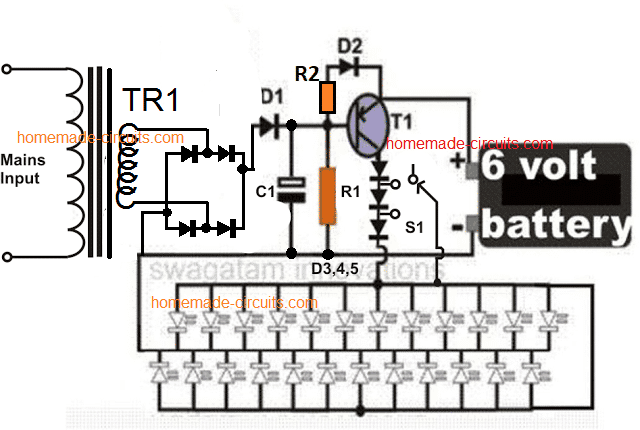
The concept: We know that LEDs require a certain fixed forward voltage drop to become illuminated and it is at this rating when the LED is at it’s best, that is voltages which is around its forward voltage drop facilitates the device to operate in the most efficient way.
As this voltage is increased, the LED starts drawing more current, rather dissipating extra current by getting heated up itself and also through the resistor which also gets heated up in the process of limiting the extra current.
If we could maintain a voltage around an LED near to its rated forward voltage, we could use it more efficiently.
That’s exactly what I have tried to fix in the circuit. Since the battery used here is a 6 volt battery, means this source is a bit higher than the forward voltage of the LEDs used here, which amounts to 3.5 volts.
The extra 2.5 volts rise can cause considerable dissipation and loss of power through heat generation.
Therefore I employed a few diodes in series with the supply and made sure that initially when the battery is fully charged; three diodes are effectively switched so as to drop the excess 2.5 volts across the white LEDs (because each diode drop 0.6 volts across itself).
Now as the voltage of the battery drops, the diodes series are reduced to two and subsequently to one making sure only the desired amount of voltage reaches the LED bank.
In this way the proposed simple emergency lamp circuit is made highly efficient with its current consumption, and it provides backup for a much longer period of time than what it would do with ordinary connections
However, you can remove those diodes if you don't want to include them.
Circuit Diagram
How this white LED Emergency Light Circuit Works
Referring to the circuit diagram, we see that the circuit is actually very easy to understand, let’s evaluate it with the following points:
The transformer, bridge and the capacitor forms a standard Power supply for the circuit. The circuit is basically made up of a single PNP transistor, which is used as a switch here.
We know that PNP devices are referenced to positive potentials and it acts like ground to them. So connecting a positive supply to the base of a PNP device would mean grounding of its base.
Here, as long as mains power is ON, the positive from the supply reaches the base of the transistor, keeping it switched off.
Therefore the voltage from the battery is not able to reach the LED bank, keeping it switched off. In the meantime the battery is charged by the power supply voltage and it’s charged through the system of trickle charging.
However, as soon as the mains power disrupts, the positive at the base of the transistor disappears and it gets forward biased through the 10K resistor.
The transistor switches ON, instantly illuminating the LEDs. Initially all the diodes are included in the voltage path, and are gradually bypassed one by one as the LED gets dimmer.
HAVE ANY DOUBTS? FEEL FREE TO COMMENT AND INTERACT.
Parts List
- R1 = 10K,
- R2 = 470 ohms
- C1 = 100uF/25V,
- Bridge diodes and D1, D2 = 1N4007,
- D3---D5 = 1N5408,
- T1 = BD140
- Tr1 = 0-6V, 500mA,
- LEDs = white, hi-efficiency, 5mm,
- S1 = switch with three changeover contacts. Using Transformerless power supply
The design presented above can be also made using a transformerless supply as shown below:
Here I will elucidate how an emergency lamp can be build without a transformer using a some LEDs and a handful of ordinary components.
The main features of the proposed automatic transformerless emergency light circuit is though very identical to the earlier designs, the elimination of the transformer makes the design pretty handy.
Because now the circuit becomes very compact, low cost and easy to build.
However, the circuit being completely and directly linked with the AC mains is hugely dangerous to touch in an uncovered position, so it is obvious that the constructor implements all the due safety measures while making it.
Circuit Description
Coming back to the circuit idea, transistor T1 being an PNP transistor tends to remains in switched OFF condition as long as AC mains is present across its base emitter.
Actually here the transformer is replaced by the configuration consisting of C1, R1, Z1, D1 and C2.
The above parts constitute a nice little compact transformerless power supply, capable of keeping the transistor switched OFF during mains presence and also trickle charges the associated battery.
The transistor reverts to a biased condition with the help of R2 the moment AC power fails.
The battery power now passes through T1 and lights up the connected LEDs.
The circuit shows a 9 volts battery, however a 6 volt battery may also be incorporated, but then D3 and D4 will need to be completely removed from their positions and replaced by a wire link so that the battery power is able to flow directly through the transistor and the LEDs.
Automatic Emergency Light Circuit Diagram
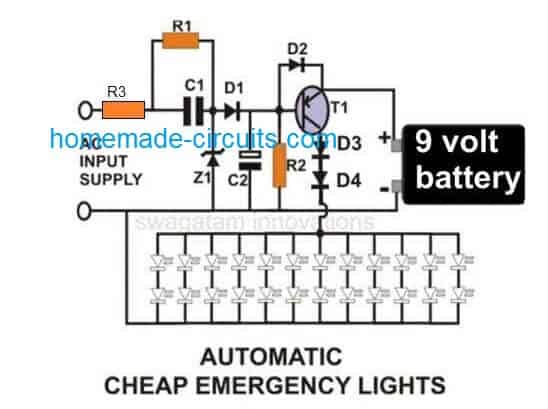
Video Clip:
Parts List
- R1 = 1M,
- R2 = 10K,
- R3 = 50 ohm 1/2 watt,
- C1 = 1uF/400V PPC,
- C2 = 470uF/25V,
- D1, D2 = 1N4007,
- D3, D4 = 1N5402,
- Z1 = 12 V/ 1Watt,
- T1 =BD140,
- LEDs, White, High Efficiency, 5mm
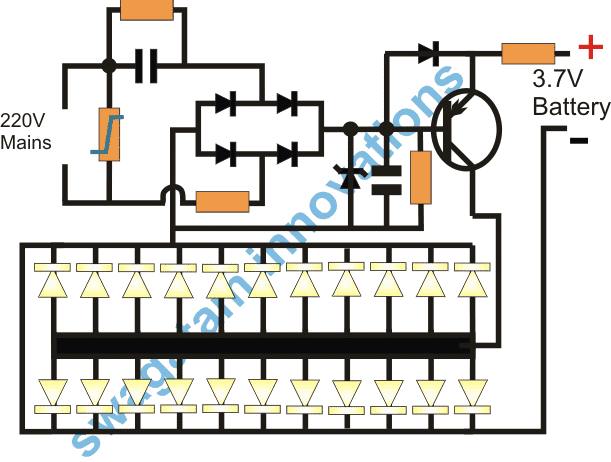
PCB Layout for the above circuit (Track side view, Actual Size)
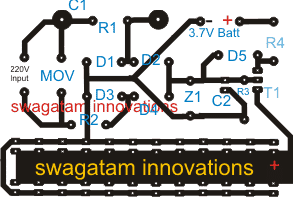
Pats List
- R1 = 1M
- R2 = 10 ohm 1 watt
- R3 = 1K
- R4 = 33 ohm 1 watt
- D1---D5 = 1N4007
- T1 = 8550
- C1 = 474/400V PPC
- C2 = 10uF/25V
- Z1 = 4.7V
- LEDs = 20ma/5mm
- MOV = any standard for 220V application
PNP BJT Current Flow
In a PNP transistor we see that current flows from the emitter to the collector when the transistor is in its "on" state. The base current which we call IB plays a crucial role in controlling how much current flows through the collector-emitter path.
Emitter Current (IE)
The current that comes out of the emitter is related to both the collector current and the base current. We can express this relationship with the formula:
IE = IC + IB
Where:
- IE is the emitter current.
- IC is the collector current.
- IB is the base current.
Collector Current (IC)
When we are in the active region the collector current is dependent on the base current through what we call the current gain (β) of the transistor. This can be written as:
IC = β * IB
Where:
- IC represents the collector current which is also the current flowing through any LED load we have connected.
- β is the current gain (also known as hFE) of the PNP transistor and it usually ranges from about 100 to 300.
- IB is again our base current.
Base Current (IB)
To figure out the base current we can use the input voltage along with the base-emitter voltage (VBE). The formula looks like this:
IB = (Vin - VBE) / RB
Where:
- Vin is the voltage we apply to the base.
- VBE is the base-emitter voltage which is typically around 0.7V when our transistor is turned on.
- RB is the base resistor that helps limit how much base current flows.
LED Load Current
Now if we assume that our LEDs are connected in the collector circuit we can relate the current through these LEDs to both the voltage drop across them and the collector-emitter voltage. The LED current can be expressed as:
ILED = (VCC - VCE) / RLED
Where:
- VCC is the supply voltage for our circuit.
- VCE is the collector-emitter voltage which should ideally be low when our transistor is fully on....typically around 0.2V or even less.
- RLED is a resistor that limits the current for our LEDs if we are using one in series.
For simplicitys sake if we assume that VCE ≈ 0V when our transistor is fully on then we can say that:
ILED ≈ VCC / RLED
Base-Emitter Voltage (VBE)
For our PNP transistor to turn on properly, we need to make sure that the base-emitter junction is forward-biased. The base-emitter voltage (VBE) for a conducting PNP transistor usually sits around 0.7V when it’s in active mode.
While this value can vary slightly depending on the specific transistor we're using, it’s generally close to that 0.7V mark.
Saturation of the PNP Transistor (V{CE(sat)})
When our PNP transistor is fully turned on or saturated, we notice that the collector-emitter voltage (VCE) drops down to a very low value, which we refer to as saturation voltage:
VCE(sat) ≈ 0.2V
This low voltage across the transistor means that most of our supply voltage gets dropped across whatever LED(s) and any current-limiting resistor we have in place.
2) Surge Protected Automatic Emergency Lamp
The following surge proof emergency lamp circuit employs 7 series diodes connected in forward biased condition across the supply line after the input capacitor. These 7 diodes drop around 4.9V, and thus produce a perfectly stabilized and surge protected output for charging the connected battery.
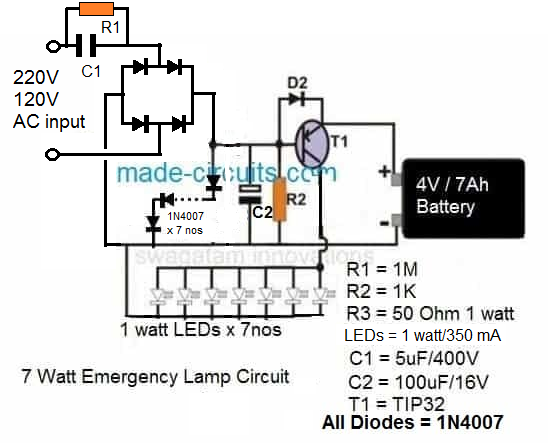
Emergency Lamp with Automatic Day Night LDR Activation
In response to the suggestion of one of our avid readers, the above automatic LED emergency light circuit has been modified and improved with a second transistor stage incorporating an LDR trigger system.
The stage renders the emergency light action ineffective during day time when ample ambient light is available, thus saving precious battery power by avoiding unnecessary switching of the unit.
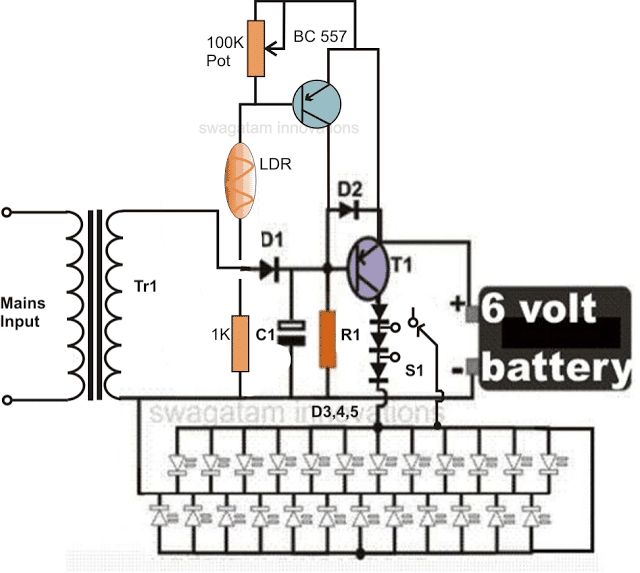
Circuit modifications for operating 150 LEDs, requested by SATY:
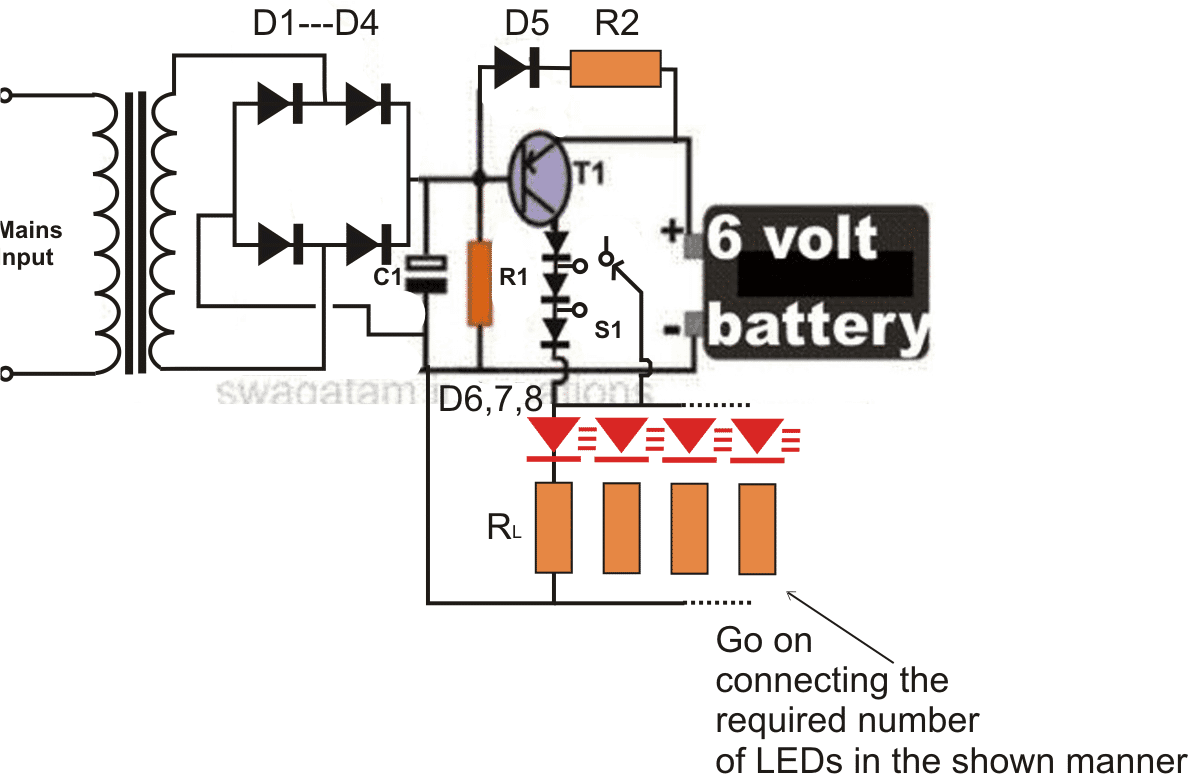
Parts List for the 150 LED emergency light circuit
R1 = 220 Ohms, 1/2 watt
R2 = 100Ohms, 2 watts,
RL = All 22 Ohms, 1/4 watt,
C1 = 100uF/25V,
D1,2,3,4,6,7,8 = 1N5408,
D5 = 1N4007
T1 = AD149, TIP127, TIP2955, TIP32 or similar,
Transformer = 0-6V, 500mA
3) Automatic Emergency Lamp Circuit with Low Battery Cut-off
The following circuit shows how a low voltage cut off circuit can be included in the above design for preventing the battery from getting over discharged.
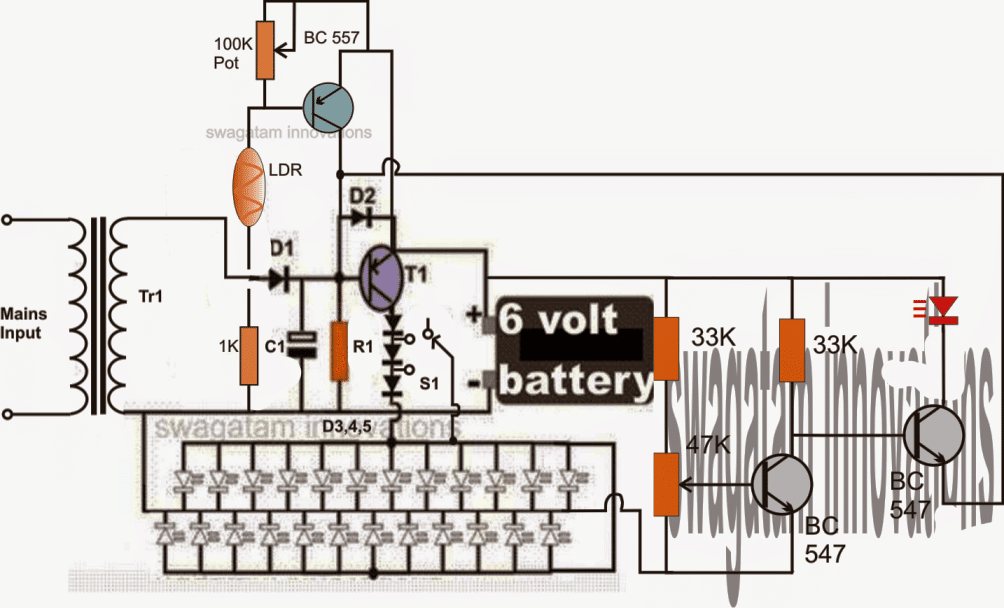
4) Power Supply Circuit with Emergency Light Application
The 4rth circuit shown below was requested by one of the readers, it is a power supply circuit which trickle charges a battery when AC mains is available, and also feeds the output with the required DC power via D1.
Now, the moment AC mains fails, the battery instantly backs up and the compensates the output failure with its power via D2.
When input Mains is present, the rectified DC passes through R1 and charges the battery with the desired output current, also, D1 transfers the transformer DC to the output for keeping the load switched on simultaneously.
D2 remains reverse biased and is not able to conduct because of higher positive potential produced at the cathode of D1.
However when mains AC fails, the cathode potential of D1 becomes lower and therefore D2 starts conducting and provides the battery DC back up instantly to the load without any interruptions.
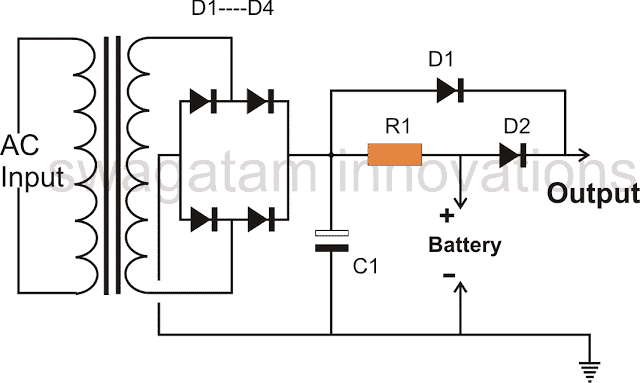
Parts List for an emergency light back up circuit
All Diodes = 1N5402 for battery up to 20 AH, 1N4007, two in parallel for 10-20 AH battery, and 1N4007 for below 10 AH.
R1 = Charging Volts - Battery volts / charging current
Transformer Current/Charging current = 1/10 * batt AH
C1 = 100uF/25
5) Using NPN transistors
The first circuit can be also built using NPN transistors, as shown here:
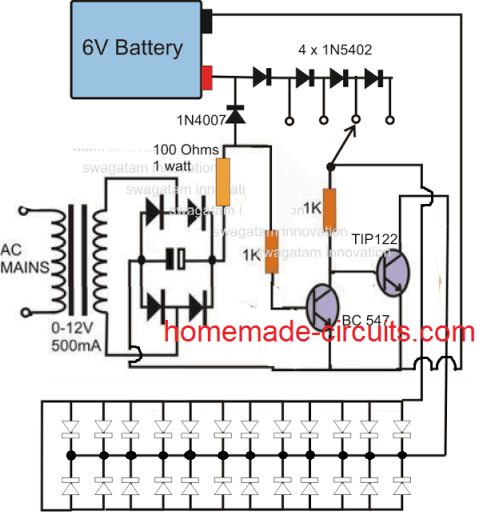
6) Emergency Lamp using Relay
This 6th simple LED relay changeover emergency light circuit using a battery back up which gets charged during mains presence and changes over to LED/battery mode as soon as mains fails. The idea was requested by one of the members of this blog.
Circuit Objectives and Requirements
The following discussion explains the application details for the proposed LED relay changeover emergency lamp circuit
I am trying to make very simple changeover circuit.. where I am using a 12-0-12 Transformer to charge a 12v Motorcycle battery via mains.
When the mains go off the battery will power a 10w LED. But, the problem is the relay is not switching off, when the mains goes down.
Any ideas. Want to keep it really simple.. 12VDC Relay / 2200uf-50v cap on Transformer.
My Response:
Hi, make sure that the relay coil is connected with the rectified DC from the 12-0-12 transformer. The relay contacts should be only wired with the battery and the LED.
Feedback:
Firstly Thanks for the Reply.
1. Yes the Relay Coil is connected with the Rectified DC.
2. If I connect the relay contacts to Battery / LED only, then how will the Battery get charged when Mains is ON?
If i am not missing anything..
The Design
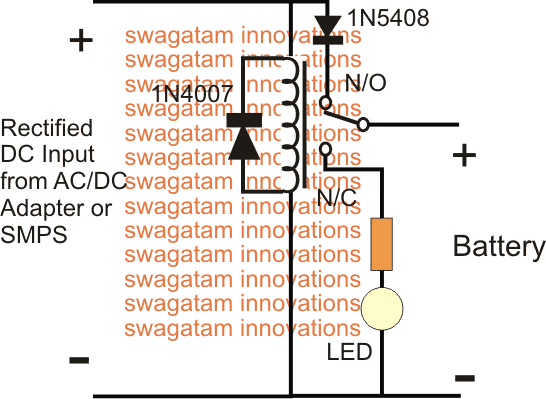
The above circuit is self explanatory and shows the configuration for implementing a simple LED relay changeover emergency lamp circuit.
Using a Relay and without Transformer
This is a new entry, and shows how a single relay can be used for making an emergency lamp with charger.
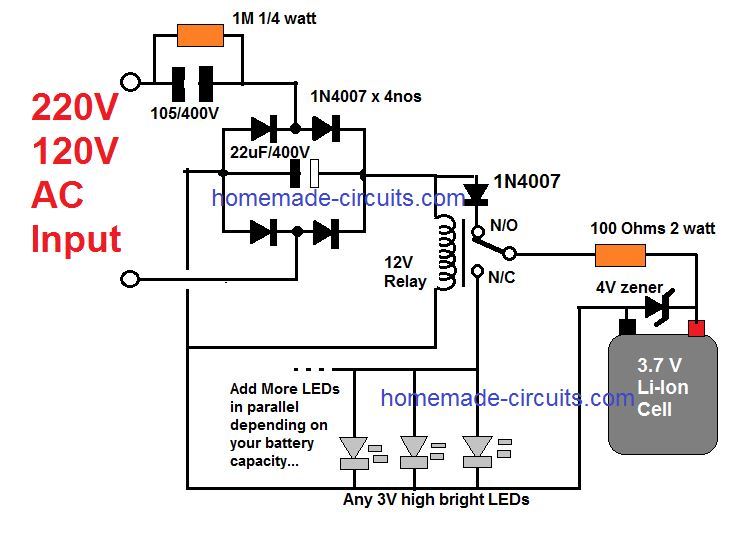
The relay can be any ordinary 400 ohm 12V relay.
While mains AC is available, the relay is energized using the rectified capacitive power supply, which connects the relay contacts with its N/O terminal. The battery now gets charged through this contact via the 100 ohm resistor. The 4V zener makes sure that the 3.7 Cell never reaches an over charged situation.
When mains AC fails, the relay deactivates, and its contact is pulled at its N/C terminals. The N/C terminals now connects the LEDs with the battery, illuminating it instantly via the 100 ohm resistor.
If you any specific questions, please ask using the comment box.
7) Simple Emergency Lamp Circuit using 1 Watt LEDs
Here I have explained a simple 1 watt led emergency lamp circuit using li-ion battery. The design was requested by one of the keen readers of this blog, Mr. Haroon Khurshid.
Technical Specifications
Can you help me design a circuit to charge a
nokia 3.7 volt battery by using regular nokia cellphone charger circuit and utilize that battery for lighting 1watt leds connected in parallel there should be light indicator and also automatic on of system in case of power failure kindly you consider my idea and design one
kind Regards,
Haroon khurshid
The Design
The requested 1 watt led emergency lamp circuit using li-ion battery may be easily built with the help of the below given schematic:
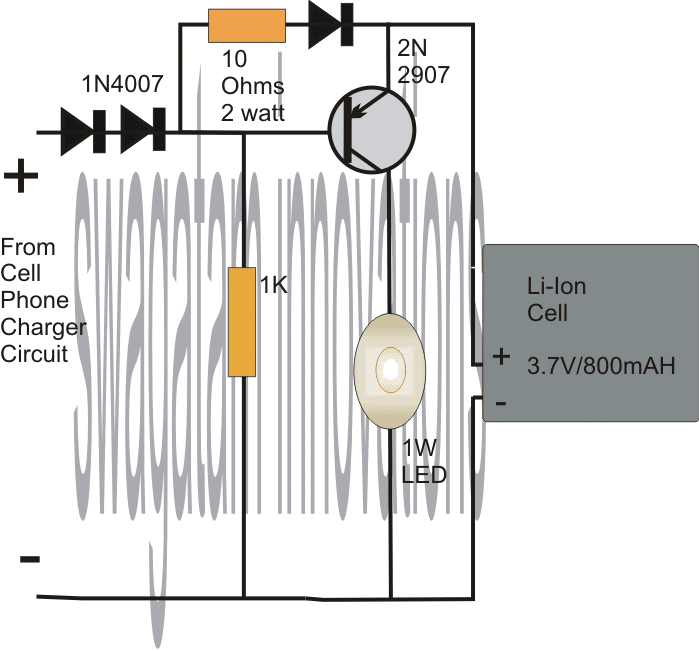
Adding a Current Control for the LED
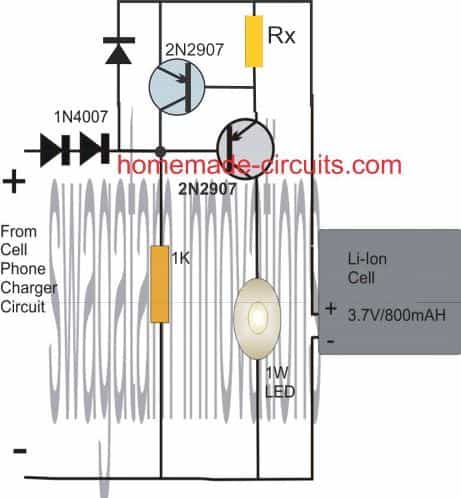
Rx = 0.7 / 0.3 = 2.3 ohm 1/4 watt
The voltage from the cell phone charger power supply is dropped to around 3.9V by adding diodes in the positive path of the supply. This should be confirmed with a DMM before connecting the cell.
The voltage should be limited to around 4V so that the cell is never allowed to cros the over charge limit.
Although the above voltage will not allow the cell to get charged fully and optimally, it will ensure the cell doesn't get damaged due to over charge.
The PNP transistor is held reversed biased as long as mains AC stays active, while the Li-Ion cell is charged gradually charged.
In case the mains AC fails, the transistor switches ON with the help of the 1K resistor and instantly illuminates the 1 watt LED connected across its collector and ground.
The above design can also be implemented using a transformerless power supply circuit. Let's the learn the complete design:
Before proceeding with the circuit details it should be noted that the following proposed design is not isolated from mains and therefore is extremely dangerous to touch, and it has not been verified practically. Build it only if you personally feel sure about the design.
Moving on, the given 1 watt LED emergency light circuit using Li-Ion cell looks quite a straightforward design. I have explained the functioning with the following points.
It's basically a regulated transformerless power supply circuit which can also be used as a 1 watt LED driver circuit.
The present design perhaps becomes very reliable owing to the fact that the dangers normally associated with transformerless power supplies are effectively tackled here.
The 2uF capacitor along with the 4 in4007 diodes form a standard mains operated capacitive power supply stage.
Adding an Emitter Follower for Voltage Regulation
The preceding stage which consists of an emitter follower stage and the associated passive parts form a standard variable zener diode.
The main function of this emitter follower network is to restrict the available voltage to precise levels set by the preset.
Here it should be set at around 4.5V, which becomes the charging voltage for the Li-ion cell. The final voltage that reaches the cell is around 3.9V due to the presence of the series diode 1N4007.
The transistor 8550 acts like a switch which activates only in the absence of power through the capacitive stage, meaning when AC mains is not present.
During the presence of mains power the transistor is held reverse biased due to the direct positive from the bridge network to the base of the transistor.
Since the charging voltage is restricted at 3.9V keeps the battery just under the full charge limit and therefore the danger of over charging it is never reached.
In the absence of mains power, the transistor conducts and connects the cell voltage with the attached 1 watt LED across the collector and ground of the transistor, the 1watt LED illuminates brightly....when mains power restores, the LED is switched OFF immediately.
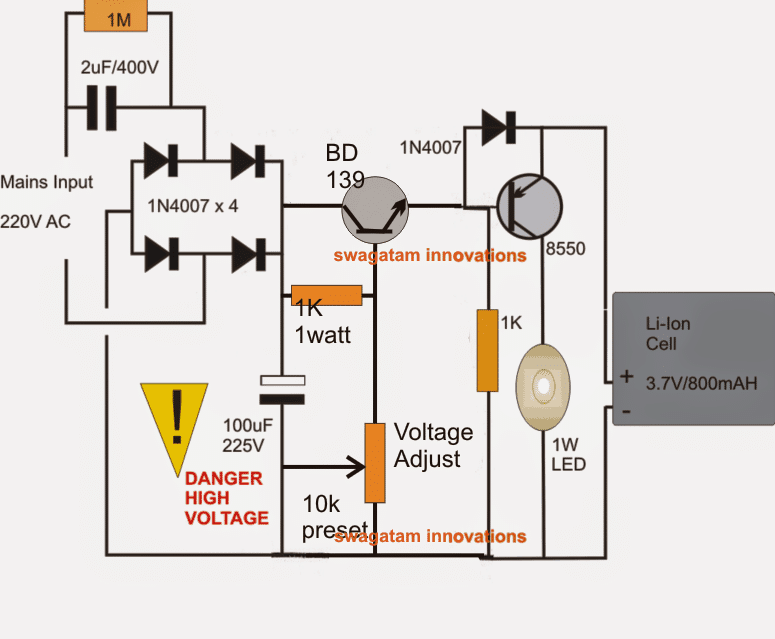
If you have further doubts or queries regarding the above 1 watt led emergency lamp circuit using li-ion battery, feel free to post them through your comments.
8) Automatic 10 watt to 1000 watt LED Emergency Light Circuit
The following 8th concept explains a very simple yet an outstanding automatic 10 watt to 1000 watt emergency lamp circuit. The circuit also includes an automatic over voltage and low voltage battery shut off feature.
The entire circuit functioning may be understood with the following points:
Circuit Operation
Referring the below given circuit diagram, the transformer, bridge and the associated 100uF/25V capacitor forms a standard step down AC to DC power supply circuit.
The bottom SPDT relay is directly connected with the above power supply output such that it remains activated when mains is connected with the circuit.
In the above situation, the N/O contacts of the relay stay connected which keeps the LED shut OFF (since it's connected with the N/C of the relay).
This takes care of the LED switching, making sure than the LEDs are switched ON only in the absence of mains power.
However, the positive from the battery is not directly connected with the LED module, rather it comes via another relay N/O contacts (the upper relay).
This relay is integrated with a high/low voltage sensor circuit stationed for detecting the battery voltage conditions.
Supposing the battery is in a discharged condition, switching ON the mains keeps the relay deactivated so that the the rectified DC can reach the battery via the upper relay N/C contacts initiating the charging process of the connected battery.
When the battery voltages reaches the "full charge" potential, as per the setting of the 10 K preset, the relay trips and joins with the battery through its N/O contacts.
Now in the above situation if the mains fails, the LED module is able to get powered via the above relay and the lower relay N/O contacts and get illuminated.
Since relays are used, the power handling capacity becomes sufficiently high. The circuit is thus able to support in excess of 1000 watts of power (lamp), provided the relay contacts are appropriately rated for the preferred load.
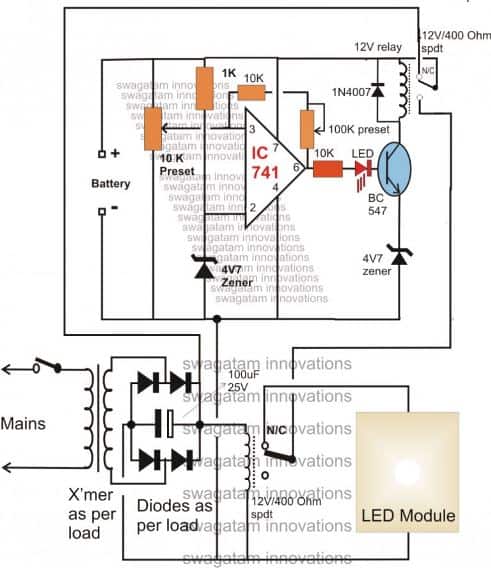
The finalized circuit with an added feature can be seen below:
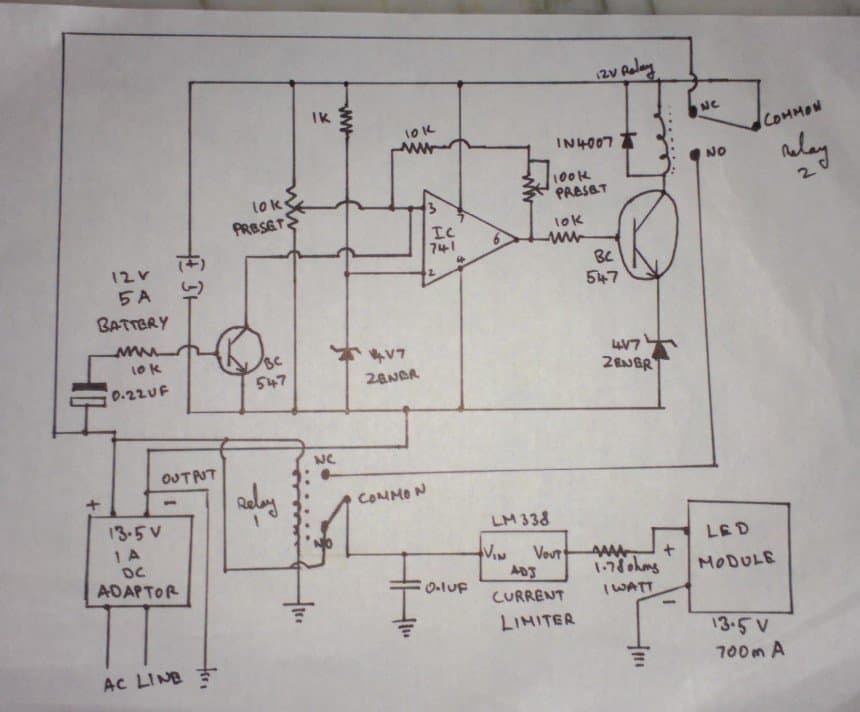
The circuit was drawn by Mr. Sriram kp, for details please go through the comment discussion between Mr Sriram and me.
9) Emergency Light Circuit Using a Flashlight Bulb
In this 9 idea I have explained the making of a simple emergency lamp using a 3V/6V flashlight bulb.
Though it's the world LEDs today, an ordinary flashlight bulb can also be considered a useful light emitting candidate especially because it's much to configure than an LED.
The shown circuit diagram is quite simple to understand, a PNP transistor is used as the primary switching device.
A straight forward power supply provides the power to the circuit when mains is available.
Circuit Operation
As long as power is present, the transistor T1 remains positively biased and therefore remains switched OFF.
This inhibits battery power from entering the bulb and keeps it switched OFF.
The mains power is also utilized for charging the involved battery via the diode D2 and the current limiting resistor R1.
However, the moment AC mains fails, T1 is instantly forward biased, it conducts and allows the battery power to pass through it, which ultimately turns ON the bulb and the emergency light.
The entire unit may be adjusted inside a standard AC/DC adapter box and plugged IN directly in to an existing socket.
The bulb should be kept protruding outside the box so that the illumination reaches the external surrounding amply.
Parts List
- R1 = 470 Ohms,
- R2 = 1K,
- C2 = 100uF/25V,
- Bulb = Small Flashlight Bulb,
- Battery = 6V, Rechargeable Type,
- Transformer = 0-9V, 500 mA
The Design and Schematic
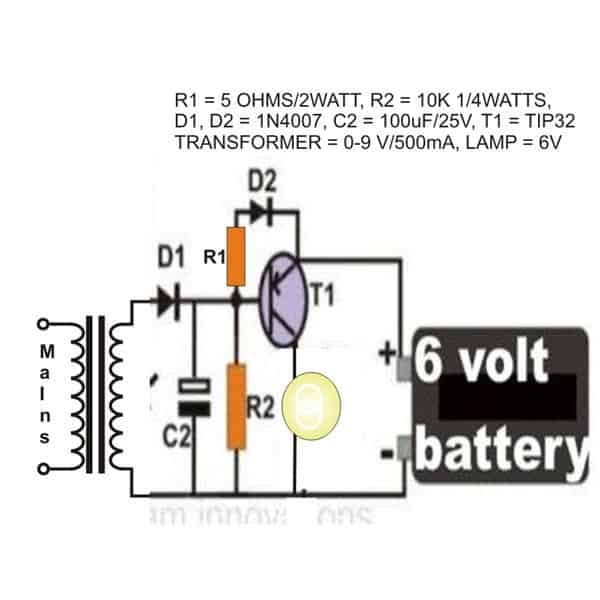
10) 40 Watt LED Emergency Tubelight Circuit
The 10th awesome design talks about a simple yet effective 40 watt LED emergency tube light circuit which can be installed at home for acquiring uninterruptible illumination at the same time saving a lot of electricity and money.
Introduction
You might have read one of my earlier articles which explained a 40 watt LED street light system. The power saving concept is pretty much the same, through a PWM circuit, however the alignment of the LEDs has been laid in a completely different manner here.
As the name suggest the present idea is of an LED tube light and therefore the LEds have been configured in a straight horizontal pattern for better and efficient light distribution.
The circuit also features an optional emergency battery back up system which may be employed for getting an uninterruptible illumination from the LEDs even during the absence of normal mains AC.
Due to the PWM circuit the acquired backup can extend up to more than 25 hours on every single recharge of the battery (rated at 12V/25AH).
The PCB would be strictly needed for assembling the LEDs. The PCB must be an aluminum-back type. The track layout is shown in the below given picture.
As can be seen the LEDs are spaced at a distance of about 2.5 cm or 25mm from each other for enhancing maximum and optimal distribution of light.
Either the LEDs may be laid over a single row or over a couple of rows.
A single row pattern is shown in the below given layout, due to lack of space only two series/parallel connection has been accommodated, the pattern is continued further on the right side of the PCB so that all the 40 LEDs become included.

Normally the proposed 40 watt LED tube light circuit, or in other words the PWM circuit may be powered through any standard 12V/3amp SMPS unit for the sake of compactness and decent looks.
After assembling the above board, the output wires should be connected to the below shown PWM circuit, across the transistor collector and positive.
The supply voltage should be provided from any standard SMPS adapter as mentioned in the above section of the article.
The LED trip will instantly light up illuminating the premise with flood light brightness.
The illumination may be assumed to be equivalent to a 40 watt FTL with power consumption of less than 12 watts, that's a lot of power saved.
Emergency Battery Operation
If an emergency backup is preferred for the above circuit, it may be simply done by adding the following circuit.
Let's try to understand the design in more details:
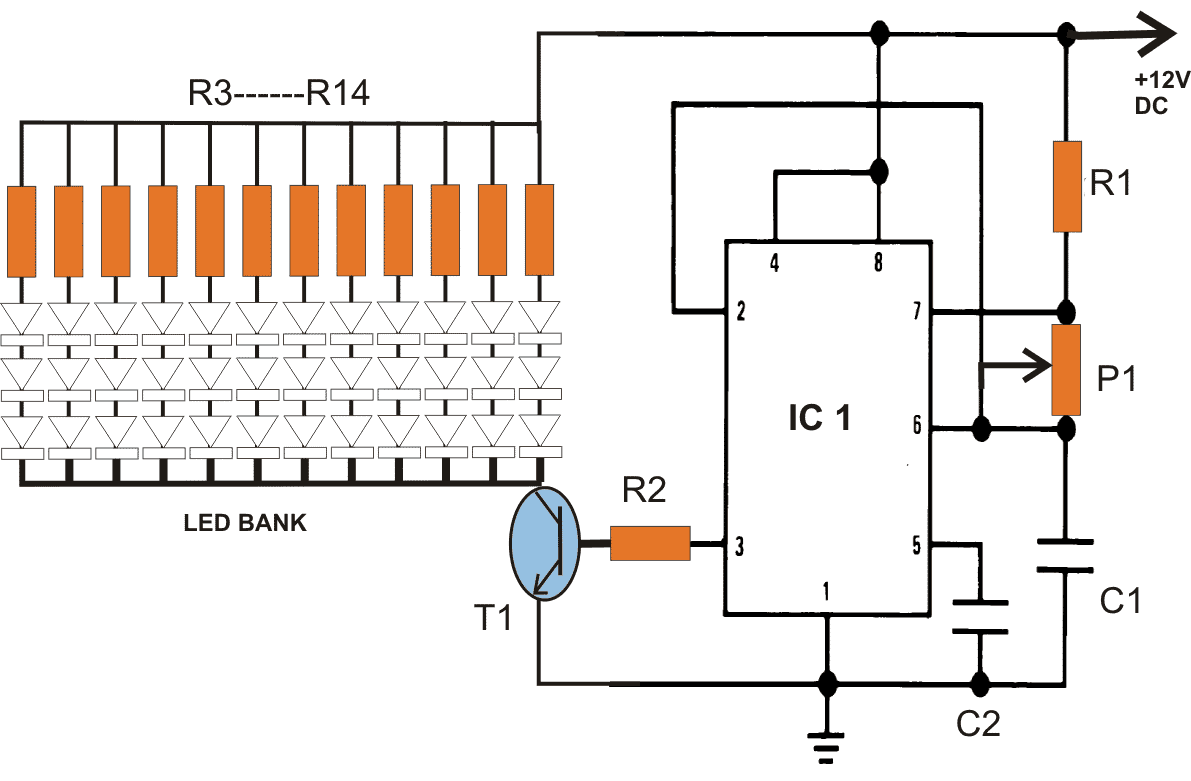
The circuit shown above is the PWM controlled 40 watt LED lamp circuit, the circuit has been elaborately explained in this 40 watt street light circuit article. You can refer it for knowing more about its circuit functioning.
Automatic Battery Charger Circuit
The next figure shown below is an automatic under voltage and over voltage battery charger circuit with automatic relay changeovers. The whole functioning may be understood with the following points:
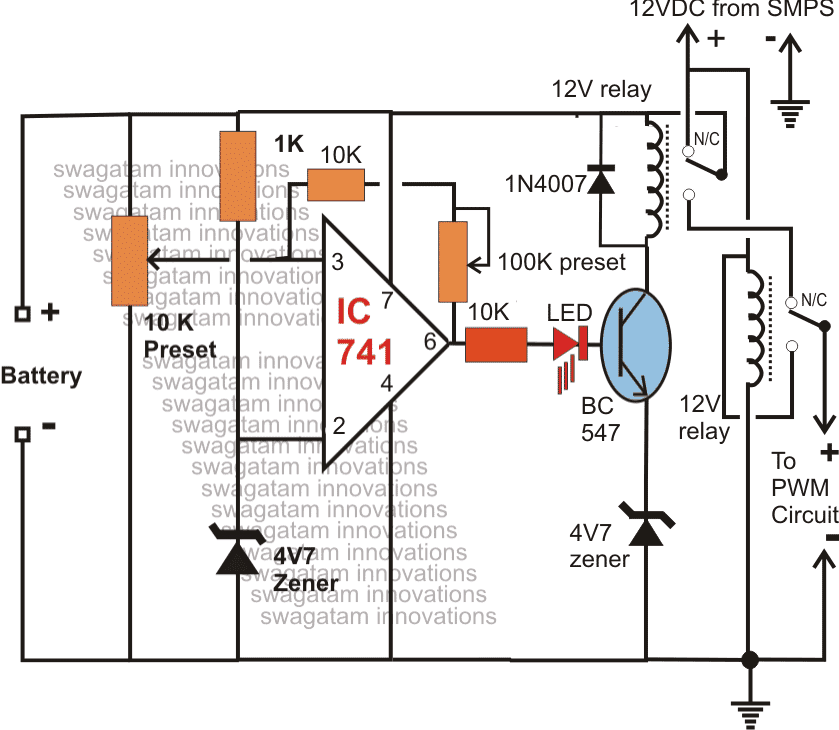
The IC 741 has been configured as a low/high battery voltage sensor and it activates the adjoining relay connected to the transistor BC547 appropriately.
Assume the mains to be present and the battery to be partially discharged. The voltage from the AC/DC SMPS reaches the battery through the N/C contacts of the upper relay which remains in an deactivated position because of the battery voltage which may be below the full charge threshold level, let's assume the full charge level to be 14.3V (set by the 10K preset).
Since the lower relay coil is connected to the SMPS voltage, stays activated such that the SMPS supply reaches the PWM 40 watt LED driver via the N/O contacts of the lower relay.
Thus the LEDs remains switched ON by using the DC from the mains operated SMPS adapter, also the battery continues to get charged as explained above.
Once the battery gets fully charged, the output of the IC741 goes high, activating the relay driver stage, the upper relay switches and instantly connects the battery with the N/C of the lower relay, positioning the battery in the standby condition.
However until AC mains is present, the lower relay is unable to deactivate and therefore the above voltage from the charged battery is not able to reach the LED board.
Now if suppose AC mains fails, the lower relay contact shifts to the N/C point, instantly connects the supply from the battery to the PWM LED circuit, illuminating the 40 watt LEDs brightly.
The LEDs consume battery power until either the battery falls below the low voltage threshold or mains power is restored.
The low battery threshold setting is done by adjusting the feedback preset 100K across the pin3 and pin6 of the IC741.
Over to You
So friends these were the 10 simple automatic emergency light circuits, for your building pleasure! If you any suggestions or improvements for the mentioned circuits please tell us using the comment box below.




Comments
Hello
thank you for nicely explained circuits of emergency lamps. I am newbie in the area and still learning and sorry for stupid question. But can you please explain if there is no risk of over charging battery in case long plug in to transformer? Can you please describe circuit that protects battery from overcharge? Thank you best regards marek
Hi, you are right, there could be a slight risk of overcharging the battery. In that case you can either decrease the input current supply to a nominal value, or do the same using a limiting resistor, in order to provide only a trickle charging for the battery. Another option is to restrict the charging voltage to the battery so that it is slightly lower than the full charge spec of the battery, through a voltage regulator…Below is a good example of a regulated supply using 7nos of 1N4007 series diodes. It restricts the voltage to the battery to around 4V, so that the battery never reaches is extreme full charging level. You can also use a combination of zener diodes to precisely set the charging voltage for the battery so that it a shade lower than the battery’s extreme full charge level.
https://www.homemade-circuits.com/wp-content/uploads/2019/05/7-watt-emergency-lamp.png
Thank you for response
Kr marek
dear Swagatam
Regarding the circuit “2) Surge Protected Automatic Emergency Lamp” let me know the connection of R3 ?in circuit cant see the R3 anywere,moreover the series 4007x7now diode polarity is also like that?
Thank you.
Hi Dr.Sison,
I forgot to show R3 in the design, this resistor can be anywhere in series with the input AC supply. However 50 ohms looks too large, instead you an use a 5 ohm resistor, even better if you replace it with a 5 ohm NTC thermistor.
Yes, the 1N4007 direction is the same as indicated in the diagram…
Dear Master,
First of all, thank you very much for your response, it was really explanatory, otherwise I could have made a mistake. I will complete the project in a few days. I think it is the best project I have found in my research. If there is a problem with anything, I will response it with you again, thank you, respectfully
You are welcome Metin,
I wish you all the best.
Let me know if you have any further questions.
Hello Swatagam, My question will be about project no:6 second scheme (without transfomer)
First of all, thank you very much for your valuable work.The side where the cathode ends of the LEDs are connected to the relay coil is also connected to one of the ac inputs. Sorry, there is a broken line in picture, I couldn’t fully understand it from the image, I would be very happy if you could help. Yours truly
Thank you Metin,
The broken line indicates, that particular line is not connected with the line which is crossing it.
So, the line which shows a break is connected only with the bridge rectifier negative, relay coil and the LED cathodes.
This line is NOT connected with the AC line which is crossing between the broken area.
I hope you got it, if not please let me know.
Sir,namaskaar mere paas 10mm led straw hat type 10 ki sankhya mein hai aur usse series mein chalane ke liye ek transformer less circuit bataye ismein kitne value ka x rated capacitor lagaye kripya bataye.
Hi Ashu, You can try the following circuit. Please replace the 12V zener diode with a 10 x 3 = 30V 2 watt zener diode.
https://www.homemade-circuits.com/wp-content/uploads/2024/04/transformerless-power-supply-circuit.jpg
Remember, this circuit is not isolated from mains 220V A and therefore is extremely dangerous to touch in an uncovered and powered ON condition.
Sir, saadar namaskaar mujhe koi zener nhi mil rha hai toh kya main iski jagah 220k resistor use kar sakte Hain agar haa toh iski value kis formula se nikale
Ashu, the 30 V zener diode is very important, a 220k resistor will not work.
If you cannot get one 30V zener, you can replace it with 3 or 4 series zener diodes.
For example you can put 3nos of 10V zener diodes in series, or 6nos of 5V zener diodes in series and so on.
Of course the requests never stop! I want my emergency light to also function as a darkness light ie in my corridor the light will turn on if a person passes from there even if the mains are still operating. So it will function in two modes: 1) emergency light when mains goes off AND it is dark, 2) motion detection light when it is dark. Thank you for beautiful work and circuits.
Please check out the following article:
https://www.homemade-circuits.com/darkness-activated-pir-lamp-circuit/
Thank you very much. I will try it.
Sure, no problem!
No problem….I will try to update the requested circuit in a new post soon…and let you know.
Thanks for your blog and all the circuits.
I wonder If you can help identify an IC on an Emergency light circuit that I have. It is similar to some of your 10 circuits, but has an IR sensor for remote control.
I reverse engineered the circuit and it is attached here.
https://drive.google.com/file/d/1A8zue9TtOUQ3scGncyNz1eC8h0eeFrYq/view?usp=sharing
Unfortunately the there is no visible marking on the IC. Please excuse the untidy circuit as I am just a beginner in electronics.
The link you have provided is not opening because you did not toggle the sharing mode, it seems. Please send it again with sharing mode ON.
Updated circuit:
https://drive.google.com/file/d/1zIRBKX2c0bK1o8z0nABnfEBrYng8LgJj/view?usp=sharing
Sorry, I tried my best, but I cannot remember any IC with that pinout configuration. It looks like a Chinese IC.
sir, gud ngt. kya hum no.9 circuit mein 9v,500 ma transformer ki jagah transformer less circuit use kar sakte hain
Yes you can use transformerless power supply in the 9th circuit, as shown below:
https://www.homemade-circuits.com/wp-content/uploads/2023/01/3V-emergency-lamp.jpg
But be careful, the circuit is not isolated from mains 220V AC.
sir, namaskaar kya hum ek 3v torch bulb ko capacitor ke saath series mein 220v ac per chala sakte hain kripya bataein
Hi Atul,
yes that is possible, you can light up a 3V flashlight bulb through a capacitor.
May I request more information on the subject? All of your articles are extremely useful to me. Thank you!
Needing some help with a circuit layout. I’m sending in 12v/5A (converting from 120v that I want to monitor). When the main power source loses power I’m switching over to 12v/9aH battery powering 20wLED. I want the led light to last as long as it can, so I need to put a float charger on a separate circuit to keep the battery charged during prolonged useage. I have tried another emergency light boards but after a period of time on battery they quit working even thought the battery is still charged. I’m shorting something out. Thanks!
The float charger can work only when mains AC input is available. The LED will last only for a period determined by the battery Ah rating and its charge level. If your emergency light board is not working despite the battery being fully charged then the LEDs might have gone faulty or maybe the controller is malfunctioning
Please I’m doing this as my final year project in the university, I want to do the design using 12v 3watts DC LED bulb. Will it work if I use two 3.7v li-ion batteries in series
A 12V LED will light up with lower brightness at 8V using two 3.7V cells in series.
Hi Swagatam,
I understand completely. I am sending you the basic schematic of a QX 5252F for your information. It is a four pin Solar Garden Light IC. The basic operation is the solar cell puts voltage into pin 1 when the sunlight shines on the solar cell. When pin one receives voltage, it turns off the output to the battery at pin 2. The IC has a diode to prevent the battery voltage from back flowing. The battery then provides voltage to the LED using the inductor and pin 4 to boost the voltage to 3+ volts. My question to you is, will the battery act similar to a capacitor and draw the voltage/current until it is full or near full which will keep the voltage/current from reaching the transistor base, so the transistor remains on until the battery gets full or near fully charged. Thanks
Hi Norman,
Yes the battery will behave like a capacitor and pull the required power for the charging process.
If you are using a PNP transistor, it will remain switched OFF as long as the battery voltage is above +0.7 V. If you want the transistor to switch OFF only at the full battery level, then you may have connect a zener diode in series with the base having a value equal to the full charge level of the battery.
Make sure to have a resistor across the base/ground of the transistor, otherwise it will never conduct. The battery (+) must be directly linked with the base of the PNP, not through a resistor.
Hi Swagatam,
I am trying to build a power failure emergency light using a single 1.2v rechargeable NIMH battery. I am trying to use the solar garden chip QX5252F so I can use one battery. The chip will also turn off the led when the unit is plugged into 120vac, the same as it does when a solar panel receives sunlight. I am also trying to provide overcharge protection as the unit will be plugged into 120vac all the time. I am using a small buck converter as power supply that reduces the 120vac to 5vdc. I am using an inline 2.4v zener and a voltage divider to reduce the power to the 1.2v battery. The idea is to deactivate the reed relay when the 1.2v battery gets fully charged. I am packaging all of this in a small plastic enclosure with US plug prongs. The schematic is attached. Your thoughts , please. I will also post my question on your site under an appropiate section.
Hi Norman, I saw your email, but since I have never used the IC QX5252F, I have no idea about it, and therefore it will be difficult for me to provide any useful suggestions.
Thank you very much sir
Hi,
You can try the concept explained in the following article:
https://www.homemade-circuits.com/using-ntc-resistor-as-surge-suppressor/
Make sure to add a 5 watt zener diode after the bridge rectifier, and add a 10 ohm 2 watt resistor in series with the NTC
Hi,
Thank you, it is called PPC capacitor ok, is it 5watt zener to be connected?.
What is NTC thermistor and how it looks?
Can you give your transformerless circuit for this? what components are in your circuit, if you have please share so that i will learn.
Thank you for your help.
With Regards
Satty
sorry link is not shared in the previous comment.
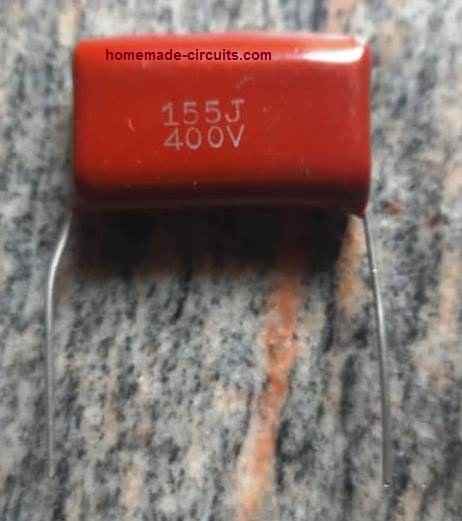
Thanks and Regards
Satty
Hi,
Thank you for your help. Yes you are right i might be confused with the number.
I have given the link for that pics. please check and let me know how to call this type of capacitor.
the number us return in that is 155J/400v.
However if you feel that this is not correct you can give me the transformerless circuit for our NPN / PNP circuit.
Thanks and Regards
Satty
Hi,
105uf is not available so 155uf is replaced.
I am using this transformerless circuit with 60 LEDs. with D945 transistor which works fine. only the battery is gone so i changed to 3.7 lithium battery to the above circuit.
However you can give me the transformerless circuit which suits for our NPN and PNP circuit which you have given to me.
Thanks and regards
Satty
Hi,
Please try this link

Thanks and Regards
Satty
Hi,
Thank you so much i will try this.
I have attached the transformerless circuit with this, please check and let me know if you need to change or modify.
the link is given below:
https://drive.google.com/file/d/1G6Y95afVXHZVCcM4TKCzJUGTBsAqU0Yi/view?usp=sharing
Thanks and Regards
Satty
Hi,
Thank you so much. You take your own time and give me the circuit.
It will be helpful for me to learn and to implement.
With Regards
Satty
OK thank you!
Hi, capacitors are named depending on their material and type. The 155j/400V is normally a PPC high voltage type capacitor.
You can use your transformerless power supply for the intended purpose, just connect a zener diode after the bridge rectifier whose voltage value should be slightly higher than the maximum battery voltage. The zener must be rated at 5 watts. Also connect an NTC thermistor in series with the 155/400 capacitor
Hi,
OK, so it’s number is 155 = 1500000pF = 1500 nF = 1.5 uF….It is not a 155uF.
Still, even a 1.5uF can also blow the transistors, there’s no way to stop this unless a zener diode and an NTC is used after the bridge.
If you are confident the circuit is alright then you can go ahead with the shown circuit.
The 155uF will burn everything on its way when power is switched ON…
The link is not opening, it is not in the shared mode!
Hi, you can try the following idea:
Hope this works!